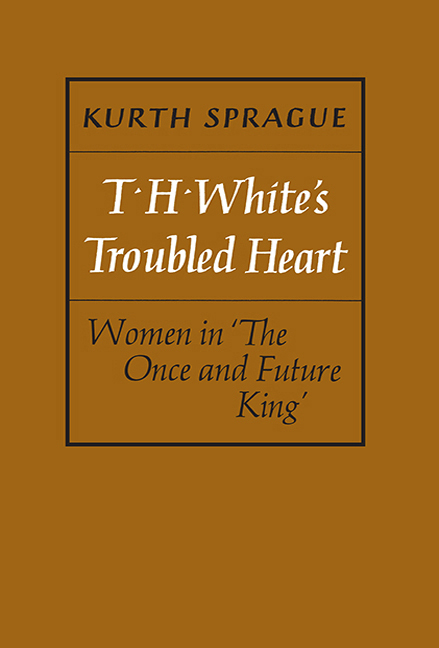Book contents
- Frontmatter
- Dedication
- Contents
- Miscellaneous Frontmatter
- Acknowledgements
- Foreword T. H. White Holdings at the Harry Ransom Center
- Preface
- Introduction
- Chapter One T.H. White
- Chapter Two Constance White
- Chapter Three White's Sources
- Chapter Four Omitted and Minor Characters
- Chapter Five Morgause
- Chapter Six Guenever
- Conclusion
- Appendixes
- Notes
- Survey of Criticism on White
- Bibliography
Chapter Three - White's Sources
Published online by Cambridge University Press: 11 May 2017
- Frontmatter
- Dedication
- Contents
- Miscellaneous Frontmatter
- Acknowledgements
- Foreword T. H. White Holdings at the Harry Ransom Center
- Preface
- Introduction
- Chapter One T.H. White
- Chapter Two Constance White
- Chapter Three White's Sources
- Chapter Four Omitted and Minor Characters
- Chapter Five Morgause
- Chapter Six Guenever
- Conclusion
- Appendixes
- Notes
- Survey of Criticism on White
- Bibliography
Summary
The genesis and growth of any literary work is a fascinating process to behold; with White and the writing of TOAFK, the fascination is increased a hundred-fold because, from the initial stage of planning to the point of execution, so much of the book's generation is clearly documented by virtue of White's letters, his journal entries, and the character of his books, in many of which he made detailed notations.
This chapter deals with White's writing plan, his use of Malory, the historical setting he chose for TOAFK, his technique of using deliberate anachronisms, his recourse to scholarship, his well-deserved reputation as an antiquary, his use of the Celtic tradition, and his attitude toward the Victorians.
WHITE's PLAN
White drafted a statement of intent, necessarily detailed and lengthy, in answer to Sir Sydney Cockerell, who had sent White some material from Morgan MS 705–806, and who had suggested a time-setting for his book of the late-thirteenth and early-fourteenth centuries:
Nothing that you could have said would have persuaded me, but the picture did the trick. I am half sorry that I decided on the 15th century, but it is too late to change, and anyway I am only half sorry. The consolation is that it is an imaginary 15th century. I am putting myself as far as possible in Malory's mind (which was a dreamer's) and bundling everything together in the way I think he bundled it. The subject is too long to explain except by word of mouth, but I am trying to write of an imaginary world which was imagined in the 15th century…. So I am taking 15th cent. as a provisional forward limit (except where magic or serious humour is concerned—for instance, it is a serious comment on chivalry to make knights-errant drop their ‘g's’ like huntin’ men) and often darting back to the positively Gaelic past (the kind of date you think of) when I feel that Malory did the same…. Malory and I are both dreaming. We care very little for exact dates, and he says I am to tell you I am after the spirit of the Morte d'Arthur (just as he was after the spirit of those sources he collated) seen through the eyes of 1939.
- Type
- Chapter
- Information
- T. H. White's Troubled HeartWomen in <I>The Once and Future King</I>, pp. 47 - 72Publisher: Boydell & BrewerPrint publication year: 2007

